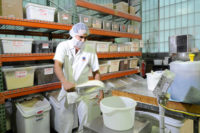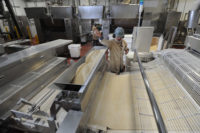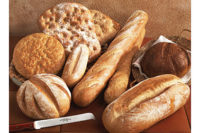Producing and Celebrating Bread














Turano Baking Co.’s Berwyn, Ill., headquarters location is a bustling, action-packed 185,000-sq.-ft. production complex, brimming with high-speed makeup lines as well as hand-crafting stations. Known by company personnel as Campagna-Turano, the plant is home to 407 employees and six production lines that process up to 1 million lb. of flour each week and approximately 1.5 millions lb. of dough each week. Customers have a need for so many different items that the lines in Berwyn alone churn out 150 to 200 of the company’s stock-keeping units (SKU) overall and produce 150 fresh SKUs daily. There can be as many as 15 changeovers a day on four of the six lines.
Some of the most sophisticated baking equipment in the world has found a home at the Turano Baking facility, as has some vintage machinery. Three of the production lines are fully automated and three are semi-automated. The newer lines have programmable logic controls, touchscreens and Ethernet capability so that the maintenance department can log in and check line efficiencies or diagnose any situation that may arise. All packaging is performed in-line with production.
“We expanded this plant several times,” observes Joe Turano, director of operations-Midwest and a member of the bakery’s third-generation management team.
Operating seven days a week, 24 hours a day, with cleaning/maintenance shutdowns that vary throughout the week depending on what’s being produced, the plant primarily serves a seven-day fresh-delivery system.
Stress-free, Automatic and Hand-crafted
In 2001, Turano Baking Co., Berwyn, Ill, installed a fully automated, stress-free line with a customized proofing system for its signature 2-lb. Pane Turano loaf, a rustic round Italian bread that was hand-made for many years. The line also generates various artisan breads, including aromatic Panini and Ciabatta and other European-style breads. At the heart of the line is a custom built, 108-ft.-long granite stone hearth tunnel oven with multiple zones that bake up the most aromatic loaves. New line additions include a fully automated racetrack cooling system and an automatic band slicer.
“We duplicated the entire production line in our bakery in Villa Rica, Georgia,” Turano says, describing the line that runs the Pane Turano. “Stress-free means the dough is worked as little as possible to maintain the quality and integrity of its cell structure, and so that it has more absorption,” Turano explains. The large round loaves are produced at speeds of 1,500 an hour (25 a min.) while 3-lb. Panini bread is made at 1,200 loaves per hour (20 a min).
“The production lines in our three other production plants are all high-speed and fully automated for their given product categories,” he points out. “But here, production space is tight, so we upgrade and further automate as we’re able to.”
The recently added racetrack cooler in Berwyn provides an additional hour of cooling time for the Pane Turano, which needs two hours to cool before slicing and packaging,” he says. “The product flows from the cooler automatically into a slicing unit and then to the packaging department.”
In 2006, the bakery added another new fully automated line that runs French bread and rolls. Despite all of the speedy automation, the bakery still makes some products exclusively by hand, in a small area devoted to specialty and artisan breads.
“We hand craft maybe five or 10 different breads for fine dining restaurants,” he adds.
On the day of Snack Food & Wholesale Bakery’s visit, the fully-automatic stress-free line was running the 2-lb. Pane Turano bread while another of the fully-automatic lines was producing 8-in. French sandwich rolls for foodservice customers (the newer of the two lines at the plant that bakes French rolls). This French bread line runs long 1-lb. baguettes at up to 3,000 an hour (or 50 a min.).
Both of the lines receive flour from a pair of outdoor silos that can each hold 100,000-lb. Water and shortening are pumped to the mixing stations from tanks. Additional “minor” ingredients such as dough conditioners, salt, sugar and block yeast, are scaled manually from bags and other containers stored in a dedicated raw materials warehouse.
Inclusions such as rosemary and other herbs, roasted garlic, cheeses, onion and many more are used in at least 15 to 20 of the items the plant produces.
Mixing, Rolling and Dividing
Production on the line running the Pane Turano rounds starts with a three-bowl carousel spiral mixing station. Having a 1,000-lb. capacity, the system prepares the dough as the bowls rotate through the station, scaling flour, water and other ingredients and progressing to mixing and resting stations. After the dough is mixed, it’s deposited into a dough trough and is allowed to ferment anywhere from 30 to 120 minutes, depending on the type of dough running on the line. Then, the dough is transferred to a hopper on the stress-free makeup line where it’s divided.
As the dough drops into the divider, it’s formed into a continuous slab. Rails divide it into separate sections as cross rollers stretch the slab thinner and thinner. The line is equipped with several sheeting, gauging and dusting stations. In this case, the dough is dusted with flour. The separated portions of dough then travel to a scale system that checks the weight and portioning before the dough is guillotine-cut into individual pieces. A spraying system and topping applicators are also part of the line, though Turano says in this particular case, they’re bypassed.
The dough then goes through a rounder and then the rounds are placed onto peel boards two-across, and are aligned by hand as peel boards convey underneath the line in a closed loop through the system. Proofing in a system that holds up to 1,200 dough pieces is next, as the dough pieces progress six-across on the peel boards and proof for about an hour.
Leaving the proofer, the loaves relax a few minutes in an intermediate step halfway through the proofing process and then go back for a final proofing. Next, the proofed pieces are scored by hand and transferred into some proprietary sections of the line that create “just the right crust” on specially designed equipment that further shapes them into the proper dimensions. The loaves are automatically removed from the peel boards before being oriented and conveyed 12-across into the long, natural gas-fired hearth oven.
The multizone, granite-stone oven bakes bread at temperatures ranging from 350-520°F for anywhere from 15-60 min., depending on the product running. There is a quality control check at the point where the loaves exit the oven and drop onto a return conveyor. Here, they travel to a tall, spiral racetrack cooler that brings them down to an ambient temperature, before they exit onto a rack-style conveyor. This conveyor elevates them out of the main room and into the packaging department as they cool for another 50 to 60 min. The Pane Turano takes nearly two hours to cool before it’s sliced.
As the conveyor lowers the round breads into the main floor of the packaging department, the loaves move single-file into the slicer and then are bagged in clear film bags printed with the Pane Turano logo, product details and the bakery logo. The bags are also automatically clipped closed and are sent through a metal detector before they’re tray-packed manually in counts of four. They also can be packed in eight-count corrugated cases for frozen distribution. The cases are sent through a tape sealer and are labeled, palletized manually and stretch-wrapped on automatic equipment. From here, fresh loaves move to the shipping dock for delivery while the case loads are put into the trucks.
A shuttle system between the Berwyn plant and the plant in Bolingbrook, Ill., transports trailerloads of the product bound for frozen distribution to the Bolingbrook freezer. There are 10 refrigerated trailers that ship at least six truckloads each day to Bolingbrook to freeze.
“Our new Villa Rica and Orlando plants are independent, where product is frozen onsite in the freezer attached to the bakery,” Turano notes.
French Roll Flair
The French rolls are made in similar fashion on another of the three fully automatic lines, but with several differences. Two vertical mixers on this line work with straight dough and there’s no floor time after mixing. In addition, minor ingredients are added by hand.
After mixing, the French roll dough is dumped into a dough trough, which is rolled over to a five-pocket divider. The divided dough then moves through a checkweigher and a rounder that forms the rolls. From the rounder, it transfers into an intermediate proofer and then after the proofer, the dough moves to a sheeter/roller that further manipulates it into a thinner sheet. It’s sheeted through curling belts and a pressure board and then back to proofing. Proofing for about 15 minutes takes place at ambient temperatures.
The proofed rolls are then molded into 36-in.-long strings, and a reciprocating belt moves them onto peel boards holding five pieces each. After a dusting of corn meal, they’re automatically oriented form a horizontal to a vertical position on the boards.
The boards make a U-turn on a conveyor leading to a main proofer, where they proof for another 60 minutes (baking temperatures and relative humidity are proprietary). After this final proofing, the rolls are scored and cut/perforated to size before they bake for 25 minutes in another multi-zone hearth oven. They exit the oven and convey to a second racetrack spiral cooler. After cooling, they progress overhead to the packaging room and follow the same procedures as the Pane Turano loaves, except that the line flow in the opposite direction from the Pane Turanos in order to save room.
Next, the golden brown French rolls are sent through a bagger that loads them into six-count clear, wicketed bags with color-coded labels. The bags are then automatically clipped closed before they convey through a metal detector that checks them for any contaminants. Packaging efficiencies and other production information appear on computer touchscreens as line operators perform quality assurance checks periodically, monitoring product weight, dimensions, appearance, color and other variables.
The bags are packed by hand into large black shipping trays that are manually palletized before the loads are whisked off to the shipping area.
Food Safety First
Food safety is a top priority at all four of Turano Baking’s production plants.
“We keep track of all food safety regulations and are always on top of them,” Turano says. “We stay ahead of the curve on food safety. We’re Safe Quality Food (SQF)-certified at the plants in Georgia and Florida at a Level 2, and are working to certify the Bolingbrook plant and then work on Berwyn,” he continues. Each facility goes through at least six audits a year, depending on chain operator requests. Turano Baking is audited annually by the American Institute of Baking International (AIB), and has received a Superior rating in Berwyn for more than 12 years.
“We’re always looking for equipment that has safe requirements,” he mentions. “For the most part, equipment manufacturers have responded with food safety and easy maintenance in mind. We are looking at automating more with computer-aided manufacturing systems. But we always give our suppliers input and recommendations to fit our needs. Overall, they’re responding very well.”
Each makeup line also conducts frequent quality control checks, regardless of the product running. And all of the lines at all four bakeries are equipped with metal detectors. But the Berwyn plant has become more process-controlled and automated in terms of quality data, Turano explains.
“In fact, we will soon upgrade process control at all of our plants,” he says. “For a pilot, we installed touchscreens in our packaging areas to provide finished orders to the packaging operators so they know immediately what quantities of product they need to package. They enter data such as quality specifications, typical bread or bun length, width and weight. These specs are checked every 15 minutes to review how the products are running. They also check product temperature and all scaling data are displayed on the screen. Our quality analyst gathers all of this data and can share it with our customers and plant personnel.”
One initiative that began last year was to further automate the packaging lines company-wide, says Turano. There are opportunities to automate case-packaging functions on lines in the 220,000-sq.-ft. Bolingbrook complex and in the 107,000-sq.-ft. Villa Rica, Ga., facility.
“We’re always looking for more efficient packaging equipment,” he adds. “We do not automatically palletize but we stretch wrap automatically in Berwyn. Being a fresh bakery primarily, the Berwyn plant has some space constraints the others don’t have. So to fully automate here—the way we have in the other bakeries—is a challenge.”
Inventory handling is computerized in Villa Rica and at the 90,000-sq.-ft. bun plant in Orlando, but Turano Baking would like to upgrade Berwyn’s inventory program, he adds.
“We have computerized the inventory handling and processing in our newer plants,” he says. “The warehouses in Orlando and Villa Rica send micro ingredients automatically to the mixers there. From an inventory standpoint, they have real-time information of all ingredients and usage information is in real time. We’re working on upgrading to that kind of technology in Bolingbrook and Berwyn.”
The degrading economy hasn’t steered clear of Turano Baking, but company management places a greater emphasis on new product development to stay on top of the competition.
“We strive to be better and more efficient at what we do when planning projects and managing the company,” says Turano. “The situation has made every bakery in the country even more competitive. But it’s making us better so that when the markets do turn around, we’re going to be much more prepared. It gives us an advantage for the future.”
Sustainability Initiatives
Reducing waste and energy usage and improving its sustainability is another Turano Baking goal. The company is evaluating the Energy Star program along with others and benchmarks its waste against all of the facilities. Improved lighting at all four locations is making things brighter in the plants and saving quite a bit of energy says Turano. A recycling program also is in place company-wide. Recycling bins are strategically located in each office and plant for separating plastics and paper.
“We’ve cut our waste dramatically over the last few years since we implemented the program,” he says. “Continuous improvement is one of our mantras.” And it seems that Turano Baking’s mantra is working well. Happy 50th anniversary, Turano Baking.
Looking for a reprint of this article?
From high-res PDFs to custom plaques, order your copy today!













